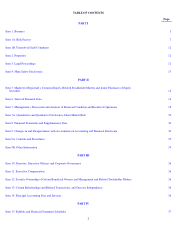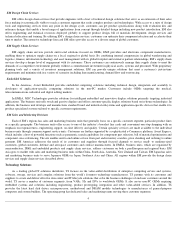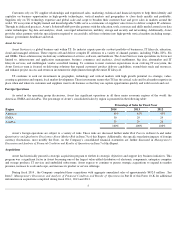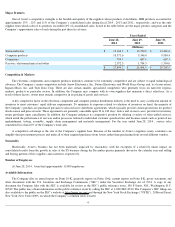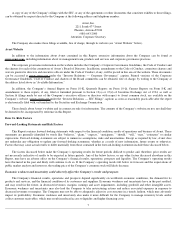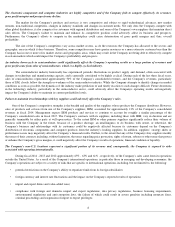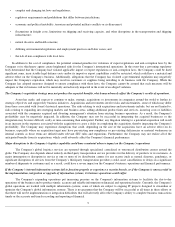Avnet 2014 Annual Report Download - page 13
Download and view the complete annual report
Please find page 13 of the 2014 Avnet annual report below. You can navigate through the pages in the report by either clicking on the pages listed below, or by using the keyword search tool below to find specific information within the annual report.
The agreements governing some of the Company's financings contain various covenants
and restrictions that limit the discretion of
management in operating its business and could prevent engaging in some activities that may be beneficial to the Company's business.
The agreements governing the Company's financing, including its credit facility and the indentures governing the Company's
outstanding notes, contain various covenants and restrictions that, in certain circumstances, limit the Company's ability, and the ability of certain
subsidiaries, to:
As a result of these covenants and restrictions, the Company may be limited in the future in how it conducts its business and may be unable
to raise additional debt, repurchase common stock, pay a dividend, compete effectively or make further investments.
The Company may become involved in intellectual property disputes that could cause it to incur substantial costs, divert the efforts of
management or require it to pay substantial damages or licensing fees.
From time to time, the Company receives notifications alleging infringements of intellectual property rights allegedly held by others
relating to the Company's business or the products or services it sells. Litigation with respect to patents or other intellectual property matters
could result in substantial costs and diversion of management and other resources and could have an adverse effect on the Company's operations.
Further, the Company may be obligated to indemnify and defend its customers if the products or services the Company sells are alleged to
infringe any third party's intellectual property rights. While the Company may be able to seek indemnification from its suppliers for itself and its
customers against such claims, there is no assurance that it will be successful in obtaining such indemnification or that the Company will be fully
protected against such claims. In addition, the Company is exposed to potential liability for technology that it develops for which it has no
indemnification protections. If an infringement claim is successful, the Company may be required to pay damages or seek royalty or license
arrangements, which may not be available on commercially reasonable terms. The Company may have to stop selling certain products or
services, which could affect its ability to compete effectively.
Failure to comply with the requirements of environmental regulations could adversely affect the Company’s business.
The Company is subject to various federal, state, local and foreign laws and regulations addressing environmental and other impacts
from product disposal, use of hazardous materials in products, recycling of products at the end of their useful life and other related matters.
While the Company strives to ensure it is in full compliance with all applicable regulations, certain of these regulations impose liability without
fault. Additionally, the Company may be held responsible for the prior activities of an entity it acquired. Failure to comply with these regulations
could result in substantial costs, fines and civil or criminal sanctions, as well as third-
party claims for property damage or personal injury.
Further, environmental laws may become more stringent over time, imposing greater compliance costs and increasing risks and penalties
associated with violations.
Tax legislation initiatives or challenges to the Company's tax positions could impact the Company's results of operations and financial
condition.
As a multinational corporation, the Company is subject to the tax laws and regulations of the United States and many foreign
jurisdictions. From time to time, regulations may be enacted that could adversely affect the Company's tax positions. There can be no assurance
that the Company’
s effective tax rate and the resulting cash flow will not be adversely affected by these potential changes in regulations. The tax
laws and regulations of the various countries where the Company has operations are extremely complex and subject to varying interpretations.
Although the Company believes that its historical tax positions are sound and consistent with applicable laws, regulations and existing precedent,
there can be no assurance that these tax positions will not be challenged by relevant tax authorities or that the Company would be successful in
any such challenge.
11
•
grant liens on assets;
•
make restricted payments (including, under certain circumstances, paying dividends on common stock or redeeming or repurchasing
common stock);
•
make certain investments;
• merge, consolidate or transfer all or substantially all of the Company’
s assets;
•
incur additional debt; or
•
engage in certain transactions with affiliates.


